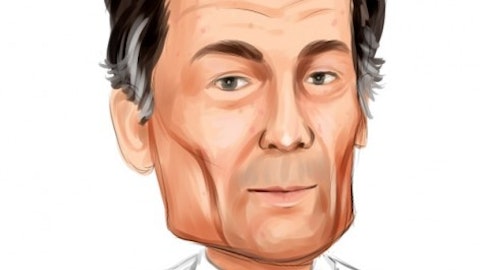Terrence Duffy: But the way you asked your question is correct. The business is not that material to CME. We are in this asset class, but we are not all-in on this asset class. I think that’s important. We’re in the liquid product, that’s it.
Owen Lau: I got it. Thanks a lot.
Terrence Duffy: Thank you.
Operator: Our last question today is from Michael Cyprys with Morgan Stanley. Your line is open.
Michael Cyprys: Thanks for taking the follow-up, appreciate it. I wanted to circle back on the Google cloud migration, and your migration of clearing services and market data to the cloud. Just curious how you think about new services that you can provide customers over time, as well as new revenue monetization opportunities over time. If you look out five, 10 years, I guess, how do you see the evolution of your business as more of it over time will be moving to the cloud?
Terrence Duffy: Sunil?
Sunil Cutinho: I will answer the capabilities and then Julie Winkler will talk a little bit about the commercialization of them. What we’ve done over the last two years is we’ve made margin calculation services available on the cloud. There are two types, one is your current margin calculation that was the first to be released, following that we allowed clients to actually calculate historical calculations. Now, we are allowing our clients to actually compute margin intra-day, so as you can see, we are progressing to give clients increased visibility into risk in a highly scalable way and far more real time. The next thing we are going to introduce for our clients is optimization. We have talked a lot about portfolio margining, we have talked a lot about portfolio margining with multiple risk pools.
Optimization is the ability to give clients the tools to move positions between these risk pools to get the best margin treatment, and we are unique in that way. We’re one of the only clearinghouses that provides these services, so we are making that available on Google cloud as well towards the end of this year as we migrate [indiscernible]. Following that, we are releasing a few APIs to some of our services that can be accessed by our clients. Our Fed Watch API, which gives clients the ability to anticipate Fed actions in our markets is now available. We have a few clients taking advantage of that. I’m going to forward that now to Julie to talk a little bit about [indiscernible].
Julie Winkler: I think Sunil touched on a few of the items that we have in process. There is certainly a distribution component to this, right – we have an extremely large market data distribution network today, and being able to offer our data in the cloud gives us another avenue to do that. It also allows us to do different data packaging than what we do today. We can provide much more customization, for example, with the offering that we have today. It’s been live for a number of years in the cloud with Google. Customers can come to us if they just want, say, crypto data as one particular example, so it’s a lot more flexibility, I would say, in the data packaging and the offering and the distribution. It allows us to also package that data in a way that is much more consumable to our clients, and we’re working with our technology teams to also find ways where we can create cloud environments where customers are taking the data from many different sources, so can we create safe, secure environments where they can bring in CME data and use it alongside their existing data, and we believe there’s some commercialization opportunities among that as well.
As I mentioned earlier, if you think about analytics and APIs, there will be commercial opportunities there. Some of that is building on analytics that we already offered, but also how we are going to look to build new things, that is going to take a little bit of time, and so I think I would think about that a little bit more of a slow burn as we set up those commercialization opportunities. Ultimately, it’s about how we can have this data reinforce both the risk management that we’re providing to our customers and also our transaction-based businesses.
Terrence Duffy: Lynne, did you want to add?
Lynne Fitzpatrick: Yes, just one thing to add there, Michael. How we commercialize these opportunities is still to be determined. These may be tools that we want to get in the hands of as many people as we can, because they might lead to more growth and trading opportunities and just overall scalability of access to our markets. We could see benefits of this coming through trading and clearing fees, we could see specific products that we want to monetize through subscription-type fees, but that’s to be determined, where you will actually see that incremental revenue.
Terrence Duffy: Michael, hopefully that gives you some clarity [indiscernible].
Michael Cyprys: Great, thanks so much.
Terrence Duffy: Thank you.
Operator: This is the Operator. I apologize for the technical difficulties experienced. Thank you very much for your patience.
Terrence Duffy: No problem.
Operator: Now I’ll hand it back to management for closing remarks.




